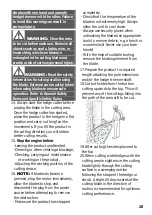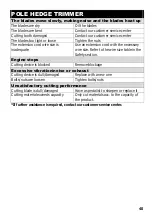
34
Maintaining The Guide Bar
Most guide bar problems can be
prevented merely by keeping the
product well maintained. Incorrect
filling and non-standard cutter and
depth gauge settings are the causes of
most guide bar problems, primarily
resulting in uneven bar wear. As the bar
wears unevenly, the rails widen, which
may cause the chain to clatter and make
it difficult to complete straight cuts. If
the guide bar is insufficiently lubricated
and the product is operated with a saw
chain which is too tight, this will
contribute to rapid bar wear. To help
minimise bar wear, maintenance of the
guide bar as well as the saw chain is
recommended.
1. Rotate the guide bar frequently, at
regular intervals (for example, after
every 5 hours of operation), to ensure
even wear on the top and bottom of
the guide bar. Refer to “the Guide Bar
and Saw Chain” in “ASSEMBLY”.
2. Disassemble the guide bar and saw
chain in reversed order from assembly.
3. Check the oiling port for clogging
and clean if necessary to ensure
proper lubrication of the guide bar and
saw chain during operation. Use a soft
wire small enough to insert into the oil
discharge hole.
NOTE:
The condition of the oil
passages can be easily checked. If the
passages are clear, the chain will
automatically give off a spray of oil
within seconds of the product starting.
Your product is equipped with an
automatic oiling system.
4. Check the drive sprocket. If it is worn
or damaged due to strain, have it
replaced by an authorised service
center.
5. Clean the guide bar groove and oil
passages whenever the saw chain is
removed, when the unit has been
used heavily or when the saw chain
appears dirty. Use a screwdriver, putty
knife, wire brush or similar instrument
to remove debris from the guide bar
groove. This will keep the oil passages
open to provide proper lubrication to
the guide bar and saw chain.
NOTE:
If the oil passages are clear, the
saw chain will give off a spray of oil
shortly after it begins to rotate during
operation.







































